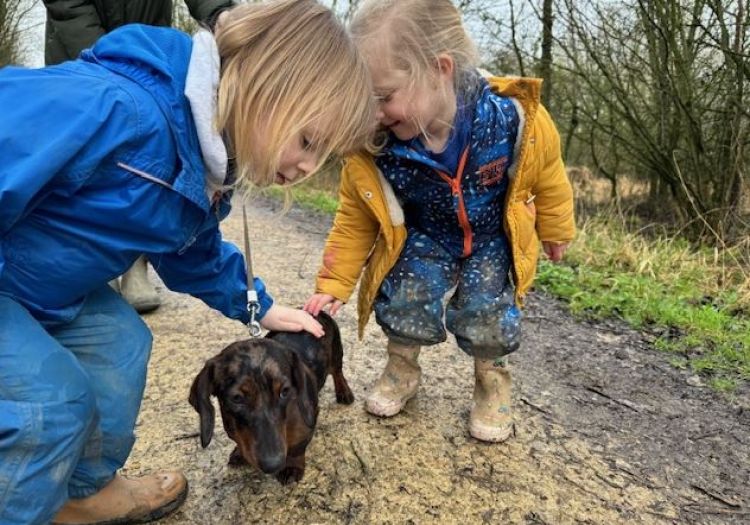Safeguarding Children in the Presence of Dogs
We have developed a new policy on this area and thought a blog might be helpful to share with parents.
Hello, I am Georgina, I am an Early Years Teacher Training Student here at Great Wood Farm on a placement in Toddler Room until February and having a wonderful experience with the fabulous staff and children at this setting. Recently a policy has been created about Safeguarding Children in the presence of Dogs, so I have been asked to explain a little about it here and provide some guidance to help parents whose children might encounter dogs regularly.
At Great Wood Farm we know that dogs can be an important part of our lives, providing companionship and lots of fun as well as a great reason to enjoy the great outdoors as a family. Owning and sharing the care of a dog brings many benefits to children, teaching them about responsibility and empathy for living creatures as well as boosting self-esteem and even improving their verbal communication skills!
In July this year Charlotte got a Dachshund puppy, Mabel, and started bringing her to work in the office. Mabel was an instant hit to both staff and children. She spends most of her days in the office and loves greeting visitors and often goes into the staff room during lunchbreaks. She also enjoys going on walks with the children and often Kindergarten children playing in the garden will come to the office door to see if Mabel is there. Growing up around nursery life has meant she has the most gentle personality and has turned into both a therapy and well-being dog - for both children and staff!
All the benefits of dog ownership do however come with some important things to consider, as it is essential that we appreciate that some dogs can cause harm to both children and adults, even those who are closest to them, something which of course we all want to avoid happening.
It is important for all of us, whether we own a dog or not, to be aware of what can cause distress or anxiety to a dog, so we can help avoid negative experiences or perhaps even a bite from a dog in our homes or when in public situations. Increasing ownership of dogs over recent years means we come across them much more now, and all children will come face to face with them in cafes, parks and even on public transport much more than in the past. Dogs come in all shapes and sizes, and some may appear quite large and intimidating to a younger child, with others looking small, fluffy and temptingly cuddly as they walk towards them in the street. Websites such as the RSPCA, PDSA and the Blue Cross contain lots of detailed advice about keeping children safe around dogs, with some presented in child friendly formats, so you can share it with older children. I have summarised the main advice here in brief:
Golden Rules for Children around Dogs:
NEVER leave children alone with dogs, no matter how familiar they are!
DO NOT allow children to approach dogs they don’t know….always ask the owner first!
Children should not be allowed to walk around while eating when dogs are nearby.
Teach your child to be gentle and play nicely with dogs, to remain gentle and calm, and avoid exciting or very noisy games when they are close by.
Explain that dogs sometimes need their own space, for example their bed or cage, and that children need to stay out of the dogs “safe space”, and not approach any dog if they are eating, playing with their toys, or sleeping. It is also important to give them a little more space if they are sick, injured and/or have hearing or sight problems.
Teach your children how to spot the signs of a dog feeling scared or worried, so they might not want to play with them. The simplest ones are those a young child can see, for example a tail being down, hiding under something or behind it or having their ears back or flat against their head. Other more subtle signs which adults should look out for are yawning, panting, pacing the room or licking their lips, all of these may mean a dog is feeling uncomfortable, or at risk, so may behave out of character or in unpredictable way. As adults we must be much more aware of these signs, as children will often mistake them for play signals or simply being tired. In these circumstances the dog must always be allowed to leave the situation themselves or be directed to their safe place straight away.
A small number of dog breeds are now prohibited under The Dangerous Dogs Act (1991) and will be illustrated in images at the end of this post. Please take note of these breeds and call 101 if you know of a dog which poses a risk to a child or is one of these breeds. Remember that being in charge of a dog that is dangerously out of control is now an offence whether the dog is in a private or public place, so you can definantly report this if you see it happening while out and about with your family.
Useful websites for more detailed guidance:
https://www.pdsa.org.uk/pet-help-and-advice/looking-after-your-pet/puppies-dogs/children-and-dogs
https://www.dogstrust.org.uk/dog-advice/life-with-your-dog/at-home/dog-and-child-safety
https://www.rspca.org.uk/adviceandwelfare/pets/dogs/company/children/safe









